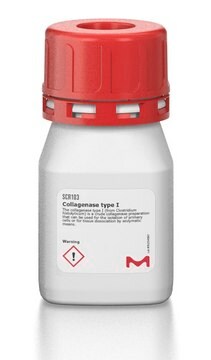Kluczowe dokumenty
C9697
Collagenase from Clostridium histolyticum
lyophilized powder (from 0.2 μm filtered solution), suitable for cell culture
Synonim(y):
Clostridiopeptidase A
About This Item
Polecane produkty
pochodzenie biologiczne
Clostridium histolyticum
Poziom jakości
sterylność
0.2 μm filtered
Formularz
lyophilized powder (from 0.2 μm filtered solution)
aktywność właściwa
≥800 units/mg solid
masa cząsteczkowa
68-130 kDa
stężenie
1 mg/mL
metody
cell culture | mammalian: suitable
pH
7.4
temp. przechowywania
−20°C
Szukasz podobnych produktów? Odwiedź Przewodnik dotyczący porównywania produktów
Opis ogólny
Zastosowanie
- Sertoli cell isolation
- Used in the comparison of enzymatic methods
- Tissue preparations for immunocytochemistry
- Testicular sperm extraction
- Preparation of single cell suspensions
- Immunofluorescence
This product is suitable for the disaggregation of human tumor, mouse kidney, human adult and fetal brain, lung and many other epithelia tissues. It has also been shown to be effective in liver and kidney perfusion studies, digestion of pancreas and hepatocyte preparation. Collagenase has also been used in the preparation of arterial tissue for the study of Advanced Glycosylation End Products. This enzyme has been tested for the release of heptatocytes at a concentration of approximately 1mg/mL. Concentrations for digestion range from 0.1 to 5mg/mL.
Działania biochem./fizjol.
Przestroga
Definicja jednostki
Uwaga dotycząca przygotowania
Hasło ostrzegawcze
Danger
Zwroty wskazujące rodzaj zagrożenia
Zwroty wskazujące środki ostrożności
Klasyfikacja zagrożeń
Eye Irrit. 2 - Resp. Sens. 1 - Skin Irrit. 2 - STOT SE 3
Organy docelowe
Respiratory system
Kod klasy składowania
11 - Combustible Solids
Klasa zagrożenia wodnego (WGK)
WGK 1
Temperatura zapłonu (°F)
Not applicable
Temperatura zapłonu (°C)
Not applicable
Środki ochrony indywidualnej
dust mask type N95 (US), Eyeshields, Faceshields, Gloves
Wybierz jedną z najnowszych wersji:
Masz już ten produkt?
Dokumenty związane z niedawno zakupionymi produktami zostały zamieszczone w Bibliotece dokumentów.
Klienci oglądali również te produkty
Protokoły
This procedure may be used for Collagenase products.
Nasz zespół naukowców ma doświadczenie we wszystkich obszarach badań, w tym w naukach przyrodniczych, materiałoznawstwie, syntezie chemicznej, chromatografii, analityce i wielu innych dziedzinach.
Skontaktuj się z zespołem ds. pomocy technicznej






